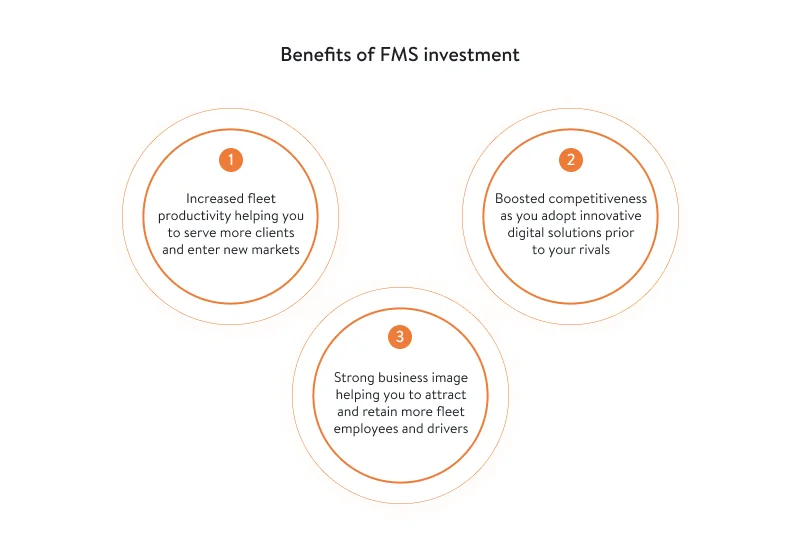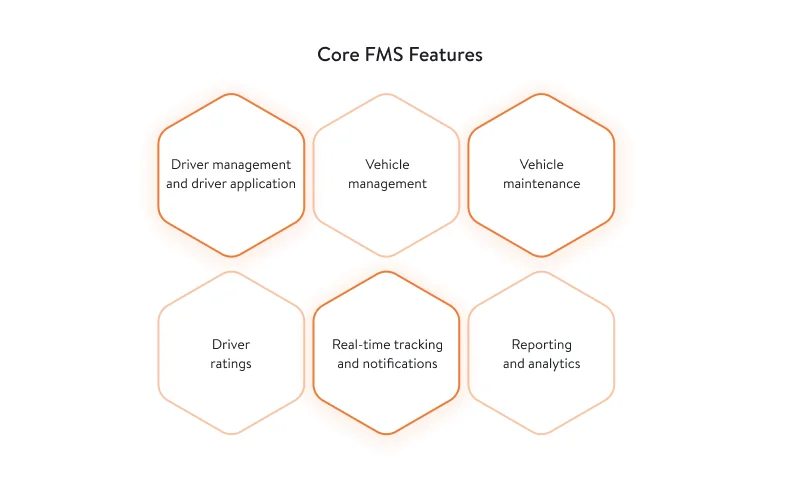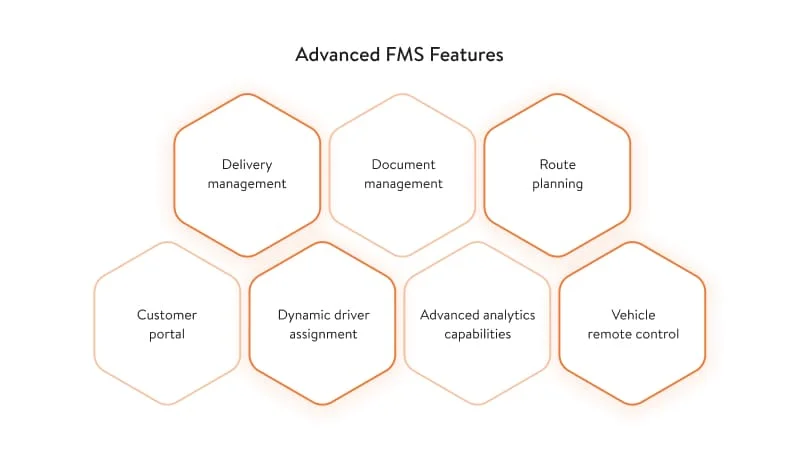The pandemic and industry 4.0 disruptions are challenging the transportation industry on a daily basis. It’s getting increasingly difficult to hire new drivers and more costly to buy, lease, and maintain vehicles. To optimize fleet expenses and retain drivers, you need to efficiently use all available fleet assets. A proper fleet management system (FMS) can help.
We aren’t here to tell you that an FMS can solve all of your transportation problems, but at least it can help you smooth out issues that disrupt your fleet from within. Those internal disruptors could be inefficient driver retention strategies (or even a lack of retention strategies), frequent accidents, and lost or damaged goods and vehicles. Read on to find out how to reduce the stress in your fleet management practices with the right FMS.
Benefits for your company of investing in an FMS
Investments in fleet technologies pay off over time, and you can see tangible results within a few months after adoption. According to a 2021 Fleet Technology Trends Report, among 700 US fleet managers who implemented fleet technologies:
- 54 percent of respondents reported improved customer service
- 32 percent reported a positive ROI in six months after adopting digital fleet innovations
- respondents reported an average 8 percent decrease in fuel costs, 11 percent reduction in accident costs, and 10 percent decrease in labor costs
In addition to optimized costs and enhanced customer service, an FMS can offer you the following benefits:

In the course of this article, we’ll explain how exactly an FMS can help you achieve these goals. But to get you even more inspired, let’s have a look at a real-life example of FMS adoption.
Real-life success story
The top Canadian carrier company Trimac decided to implement an FMS solution in 2019 when the Electronic Logging Device (ELD) requirement by the Federal Motor Carrier Safety Administration (FMCSA) came into effect. The company’s management was looking for a modern and driver-friendly FMS solution that could cover their requirements:
- regulatory compliance in Canada and the United States
- full implementation for 1,650 vehicles in 45 locations
- fast driver onboarding
After analyzing the market, Trimac’s team couldn’t find a suitable driver-centric end-to-end solution with a sufficient level of scalability to cover the whole transportation flow. Thus, Trimac opted for development of a customized FMS with incremental implementation. After launching a pilot project for only 125 vehicles, Trimac already saw the following results:
- 3 times the number of high-safety drivers
- 53 percent decrease in harsh maneuvers
- 1 hour a day saved on data entry per dispatcher
- less paperwork for drivers
- more proactive truck maintenance
There are numerous success stories like Trimac’s, as fleet technologies are great facilitators in the transportation industry. Let’s now focus on issues of the day in the fleet industry to figure out how fleet technologies can help in dealing with them.
Read also: HOS electronic logbook solutions for the US, Canada, the UK, and Australia
How fleet automation software can help to solve current fleet industry disruptions
Fleet management involves both the transportation company and commercial drivers. That’s why we’ve decided to look through disruptive issues for both companies and drivers in 2021 according to the American Transportation Research Institute (ATRI). We’ll take the top three issues that drivers and carrier companies struggle with and consider how an FMS can help both sides.

Read also: Our blockchain logistics expertise
Solutions to commercial drivers’ issues
Issue #1. Driver compensation and truck parking
Logically, drivers care a lot about their compensation. And according to Indeed’s findings, only 51 percent of US truck drivers are satisfied with their salaries. In fact, owner-operators and independent contractors earn significantly more than company truck drivers.
Digital innovations for fleet and driver management can come in handy with solving this issue. For instance, by reducing fuel and accident costs as well as offering proper support on the route, an FMS can save you money, allowing you to offer drivers competitive compensation.
Another possible way to offer your drivers more compensation would be to integrate a reward system into your FMS. This system could be based on saved fuel costs or safely driven miles, for instance. It could also motivate drivers to use software solutions and telematics devices.
Let’s now switch to truck parking, which shares first place with driver compensation on the list of drivers’ complaints. Within the FMS can be a module that allows dispatchers or fleet managers to book parking spots for drivers in advance when planning a route. Such advance booking can not only save fuel that drivers consume while searching for a parking spot but also increase the driver satisfaction rate.
Issue #2. Detention at customer facilities
Often, drivers spend hours in the shipper’s or receiver’s yard waiting for their turn to load or unload. According to ATRI, root causes of this issue can be as follows:
- dock employee issues (e.g. errors in loading or unloading schedules, insufficient number of workers that slows down the process, broken equipment)
- unreadiness of goods
- lack of dock space
- overbooking
Of course, detention issues should also be tackled on the shipper’s and receiver’s sides. But since you don’t have any control over them, let’s focus on what you can control. First of all, the right FMS can get up-to-date data on the readiness of goods from shippers’ or receivers’ facilities. It can then give a fleet manager instructions to build a route for the driver only when the goods are ready.
Apart from that, an FMS allows for scheduling exact time slots with shippers or receivers to avoid overbooking. An FMS can also send customers timely notifications about a driver’s arrival to give them time to prepare beforehand. And in case of detention, the FMS can report it and automatically generate a compensation request for the customer.
Issue #3. Fuel prices
We have absolutely no control over fuel prices. But with the help of optimal route planning, analyzing real-time data from an odometer, and telematics devices like speed governors and GPS trackers, you can optimize fuel expenses in your fleet. A proper FMS can include all of the above possibilities.
Another big step would be to aggregate and then analyze all received data from all fleet vehicles to define the optimal speed and routes to reduce fuel consumption.
And when speaking of fuel, it’s hard to avoid the topic of alternative fuels and electric vehicles, which are steadily gaining popularity in the transportation industry. For instance, FedEx is planning to switch its entire fleet to electric vehicles by 2040. You can always consider this option and build an FMS that can help you manage alternative fuels or electric vehicles even before it becomes mainstream.
Let’s move on to the top three issues transportation companies struggle to cope with.
Solutions to motor carriers’ issues
Issue #1. Driver shortages
Driver shortages are currently the most disturbing issue for carrier companies. ATRI states that the average age of long-haul truck drivers is 46 and the average age for new entrants is 35, though the legal age to drive a truck in the US is 21.
The transportation industry is taking diverse approaches to attract younger drivers. But the problem is that young people aren’t that willing to become truck drivers. To consider these jobs, they need:
- proper salaries
- due respect
- comfortable working conditions
- work–life balance
One possible way to win young people’s hearts is with technology. Young drivers are eager to adjust to industry innovations. If you offer them comfortable vehicles packed with modern devices, you can break common stereotypes about truck drivers. Thus technology and make this job more prestigious for younger generations. It’s an inevitable truth that by keeping up with digital trends, your company can attract more talents.
Issue #2. Driver retention
Increasing retention bonuses is a great way to convince your existing drivers to stay with you. However, a proper FMS can also add value to your retention strategies. An FMS often comes as a package including a web platform and driver application. An application built with real drivers’ experiences and problems in mind can significantly simplify drivers’ work. For instance, a driver may use an app to:
- quickly find orders with filtering
- confirm pick-ups and drop-offs
- view assigned routes
- receive notifications about detours due to road conditions
- chat with fleet managers, shippers, and receivers
- stay HOS and ELD compliant
- make use of gamification and earn bonuses for accomplishments like delivering ahead of time
By gathering drivers’ feedback on using the app, you can adjust and improve it to cover more drivers’ needs. Asking for product feedback can help you stay in touch with your drivers and prove that you care about them.
Issue #3. Lawsuits
Staged accidents involving commercial vehicles are a way for people to get insurance compensation from a carrier company in the course of a lawsuit. Even though lawsuit abuse reform happened long ago, sometimes it’s difficult to prove that an accident was staged even if the commercial driver says it was. The solution could be front-facing dash cams installed on commercial vehicles to record an accident if it occurs. Such cameras can immediately transmit video and image data to an FMS to record reliable proof of a staged accident, saving the carrier’s money.
As you can already see, an FMS can be a great problem-solving tool that can help you avoid driver churn, extra expenses on fuel and vehicle maintenance, and accidents. In the next section, we’ll define when it’s preferable to invest in a ready-made solution and when it’s best to invest in a custom solution.
Out-of-the-box FMS solutions compared to custom solutions
Let’s first have a look at available FMS solutions to analyze their specifics with a primary focus on feature sets.
Ready-made FMS solutions
We’ve decided to briefly overview five common ready-made FMSs to spot their benefits and disadvantages.
Fleetio is a fleet management solution offering a vast range of features for efficient fleet, asset, and driver management. It provides integrations with diverse telematics devices, fuel cards, and software systems including other fleet management solutions. This digital platform is suitable for fleets of different sizes.
Locus is a supply chain platform that apart from fleet management covers such tasks as dispatch and route planning, real-time tracking, and supply chain data analytics. Locus provides solutions for the e-commerce, 3PL, retail, consumer packaged goods (CPG), and fast-moving consumer goods (FMCG) industries.
FleetWave is a fleet management platform for centralized fleet and driver management. It helps to eliminate paperwork and keeps all fleet and delivery documentation digitized. Among its many features, FleetWave provides:
- smooth integration with third-party software
- advanced analytics to proactively tackle fleet management issues
- inventory management
Onfleet is a delivery management platform for ensuring efficient last-mile deliveries. It offers:
- an AI-based solution for automated dispatch route planning
- real-time vehicle and driver tracking software
- an app for drivers
- comprehensive reporting on key metrics
Samsara is an FMS solution with complete HOS and ELD compliance. It also provides a convenient driver app for:
- ELD compliance
- documentation management
- real-time communication and updates
Along with offering an FMS, Samsara offers a wide range of telematics devices for the whole fleet industry. For instance, the Samsara FMS can integrate with front-facing and dual-facing AI dash cams. A front-facing dash cam captures only the situation on the road. A dual-facing dash cam can also monitor the driver’s behavior.

When analyzing out-of-box solutions, we came to the conclusion that there is no solution that covers all fleet management needs. Some options are better than others with wide functionality sets, but they may lack such crucial features as an application for drivers or incident reporting.
Often, carrier companies have to use several FMSs to cover their needs. As a result, the following issues may arise:
- limited data exchange between systems
- some features can exist in more than one system, confusing users
- double or even triple the expenses
- issues in one system can block the workflow in another
In the next section of this article, we’ll have a look at the possible benefits of a custom FMS.
Custom fleet management software development
Often, when clients come to us with a request to develop a custom FMS from scratch, they also need mobile apps for drivers. Many off-the-shelf solutions lack these. One of our recent clients decided to cooperate with us as they were unsatisfied with the outdated design, scalability, and features of their existing FMS. Purchasing a ready-made solution also wasn’t an option for them as none of the existing fleet management solutions could cover all their needs.
A custom FMS can target any kinds of users you need, including fleet managers, fleet admins, drivers, and customers. You can also build a solution only for fleet managers and admins or only for drivers depending on your company’s structure.
A microservices architecture could be the most suitable for a custom FMS to help the system scale in different directions. But a pilot version of a custom FMS can already offer the following:
- vehicle management and maintenance
- user management
- real-time vehicle and driver tracking
- reports on engine performance, fuel consumption, driver performance, etc.
- driver management and assignment
Custom development allows you to take into account all the requirements you need to meet, as you aren’t limited in functionality, fleet size, or platforms. Plus, custom development allows for implementing an FMS based on your usual monthly transport loads to ensure smooth system performance as well as future scalability.
However, developing an FMS from scratch doesn’t mean you should include as many features as possible because you can. You may need an FMS that, besides fleet management, offers document management, billing and invoicing, and a driver application. However, you may fail to find a solution that has all three components. This is when you can opt for developing software from scratch. Fleet management software development is like building with Legos, only it’s you who chooses how to combine all the bricks as well as their look and feel.
Let’s move to FMS functionality to see what features you can include in an FMS to achieve tangible ROI and improve fleet productivity.
Read also: Ultimate guide to evaluating a software development partner based on your needs
FMS functionality
Whether you’re looking for an off-the-shelf FMS or building a custom FMS, there are some basic features you will need. We’ve determined a number of important and advanced FMS features worth analyzing before you make your final decision.
Core FMS functionality
Below are core features that should be in your fleet software solution:

- Driver management and driver application. When building or choosing a digital technology solution for your fleet, remember about drivers, as their performance and satisfaction are crucial for fleet efficiency. Your FMS should allow you to assign drivers to vehicles, routes, and orders as well as monitor drivers’ profiles — for instance, to ensure timely license renewal. An application can help drivers track their deliveries and performance.
- Vehicle management. This is an obvious but crucial feature that requires your software to integrate with telematics devices. These devices are vital to get real-time information on fuel levels, engine performance, odometer readings, excessive idling, braking, speeding, and much more. Vehicle management functionality can help you achieve complete fleet visibility and always be aware of the current state of your vehicles.
- Vehicle maintenance. This functional module allows fleet managers to schedule time-based (e.g. every month) or odometer-based (e.g. every 5,000 km) maintenance for every vehicle. When the time comes for maintenance, fleet managers and admins receive instant notifications. Thus, fleet admins don’t have to keep any additional records of vehicle maintenance, as they can manage it within one web-based fleet management system.
- Driver ratings. An FMS can also use algorithms to calculate drivers’ scores based on data on speeding, harsh braking, harsh turning, and excessive idling. These scores can provide insights into drivers’ performance and help you monitor compliance with rules. Your FMS can also support a usage-based insurance (UBI) policy, which allows an insurance company to track commercial drivers’ behavior on the road via data from telematics devices. If drivers comply with all the rules, your company can get insurance discounts.
- Real-time tracking and notifications. This feature allows you to gain insights into fleet performance, such as by seeing vehicle statuses (active, inactive, in service). And in the event of road incidents, fleet managers and drivers can receive real-time notifications.
- Smart reporting and analytics. An FMS can generate thorough reports for any selected time period. Such reports could include a fleet consumption report, driver monitoring report (a summary of a driver’s scores), and vehicle usage report, showing how effectively the fleet is used.
These are a few critical features an FMS should have, but let’s find out some advanced features you might consider.
Read also: Carrier scorecard: how to effectively implement metrics to improve logistics services
Enhanced FMS capabilities
This section overviews additional features that can let your FMS do much more than only with a basic feature set. We’ve also included in this list a few logistics modules to make your FMS even more versatile.

- Delivery management. You can include this module in your FMS to schedule and manage deliveries as well as combine fleet and delivery data in one place.
- Document management. Paperwork is often time-consuming. Drivers tend to miss bills of lading (BOLs) and forget to receive proofs of delivery (PODs). To avoid this, consider digitizing all vital documents. With document management, an FMS can generate and save transportation documents for drivers and fleet managers to access anytime. Such functionality can also allow drivers to take photos of delivery documents to make them available for other software users right away.
- Route planning. You may already have this feature in your transportation management system (TMS), but you can also consider adding it to your FMS. With route planning functionality, fleet managers can build routes and assign drivers to them in one system. Plus, if anything unexpected happens on the road, a dispatch manager can quickly adjust waypoints or even the whole route manually.
- Customer portal. A self-service customer portal in the FMS can save your employees’ time on endless phone calls and email exchanges with customers. In a customer portal, your customers can track deliveries, view order status updates, manage documents, and do much more.
- Dynamic driver assignment. This feature is more like an extension of the driver management module. It allows you to swap drivers between vehicles, deliveries, and routes based on driver absence. This can help you avoid delivery delays and ensure an uninterrupted delivery flow.
- Advanced analytics capabilities. To analyze unstructured data like video from dash cams and real-time data on road traffic or weather, you can implement AI- and ML-based advanced analytics. It may even be possible to integrate the FMS with your data lake or data warehouse to get access to a wide pool of data from third-party software or other logistics management systems.
- Remote vehicle control. A forward-looking FMS can allow fleet managers and admins to manage their fleet vehicles remotely. This means that if needed, managers or admins can block a particular vehicle via the FMS web platform or mobile application.
This isn’t an exhaustive list of advanced features you can potentially include in your FMS. Each fleet has unique needs as well as unique people working in it. To make your FMS future-ready and truly beneficial for your business, you can research your employees’ pain points and define which features would best address them.
Here’s an easy checklist on how to choose fleet management software:
- Make a list of pain points, requirements, and necessary features
- Research ready-made options and analyze to what extent each can fulfill your needs
- If you can’t find a suitable solution on the market, consider custom FMS development services
Even if at first custom development seems time-consuming and costly, in the long run, one tailored solution can save you more time and money than switching between different ready-made FMS solutions. And if you do decide to develop an FMS from scratch, make sure to find a software engineering partner that can properly collect and process your requirements so your FMS can help you achieve your business goals. At Yalantis, we have extensive expertise in implementing suitable software solutions for our supply chain clients. FMS development can be the next step on your digital transformation route, and you can trust our team of professionals to guide you.
Rate this article
5/5.0
based on 1,105 reviews







